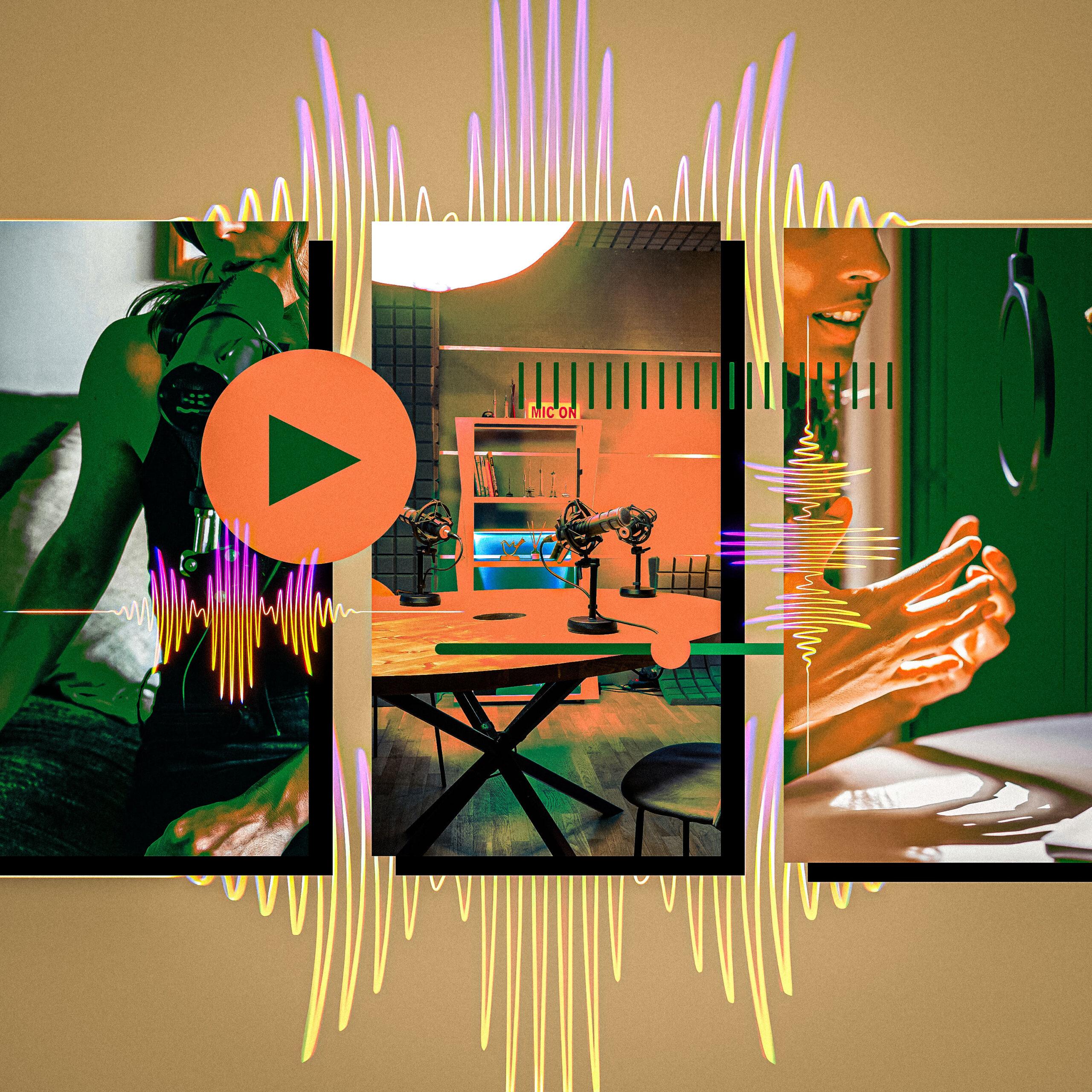How Video Streamers Conquered the Media
The written word and the news media are less influential than ever before. Web video, meanwhile, is thriving—even as many of its creators operate like traditional journalists and critics. Well, kind of.“Reading is passé,” a fellow journalist tells me frankly, and not even defeatedly. It is what it is.
The written word and the news media are less influential than ever before. “Journalism,” in some circles, is a contemptuous byword, referring to a terminally discredited profession of glorified gossipmongers trafficking in obnoxious bias and cynical clickbait. We’ve exited the golden age of blogging and entered the still more ominous age of user-generated content, and now AI-generated content. You might view it all pessimistically, as a world-ending scourge of misinformation. You might view it all optimistically, as a great democratization of discourse. Elon Musk has, in recent weeks, since the second election of Donald Trump, repeated an invocation to the users of his increasingly chan-ish social media platform: “You are the media now.”
This year we witnessed “the first influencer election,” as even the presidential candidates seemed to prioritize engagement with the creator economy over the standard interviews with CBS, CNN, and The New York Times. Trump sat with Joe Rogan and Theo Von; Kamala Harris sat with Alex Cooper, Brené Brown, Stephen Jackson, and Matt Barnes. Both candidates occasionally humored the TV news networks, too, but sparsely, grudgingly. That Trump and Harris conspicuously avoided the press suggests that the crises of trust and relevance have become much bigger than a bunch of disgruntled conservatives bemoaning the liberal media. That Trump won again, as the explicitly anti-press candidate, suggests that the crises may well prove fatal to journalism as we know it.
The news media landscape has, in fact, disintegrated, as prominent writers continue to defect from prestigious mastheads—The New York Times, The Washington Post, New York magazine, Vox, The Verge—to newsletter platforms that let them sell their bylines directly to readers, via paid subscriptions. A couple of months ago, Tina Brown, the legendary former editor of Vanity Fair and The New Yorker, launched a weekly newsletter, Fresh Hell, on Substack; I can think of no more ominous defection than hers from so-called legacy media.
The writing that does thrive in this new environment is widely fragmented and intensely polarized. There’s Substack. There’s microblogging. But really there’s one media format that has eclipsed all manner of text-based web journalism—if not all manner of writing in general—and that’s video. User-generated video, specifically, on platforms such as YouTube, Twitch, and TikTok. User-generated content is a $4 billion industry, with more than 3 billion regular viewers of web video accounting for 82.5 percent of global web traffic in 2024. The written word used to dominate online discourse. It’s now a sideshow. In the past decade, Anthony Fantano became the biggest music critic; Jason Gastrow, a.k.a. dunkey, became the biggest video game critic; and Mike Stoklasa, Rich Evans, and Jay Bauman of Red Letter Media became the biggest movie critics. These guys are far more popular and almost certainly far better paid than even the very top writers in journalism these days.
Though the term “web video” obviously describes a media format, you can also think of it as a subculture or counterculture, with its own norms, standards, ethics, and audiences in contrast with web journalism. The content creator might be an awesomely skilled gamer or a widely trusted reviewer, but they’re also an entertainer with fans in their own right. The web journalist and the content creator aren’t strictly or necessarily opposed to one another. You’d maybe think they’d be able to comfortably coexist and constructively interact as parts of two content-driven ecosystems. Realistically, though, the web journalist and the content creator are locked in a zero-sum war for attention spans—a war that the web journalist has at this point decisively lost.
I wanted to better understand why. To this end, I recently spoke with a variety of writers and creators in both formats about the demise of text-based web media—websites, blogs, magazines—and the rise of web video. The figures in this story are all associated with gaming, the entertainment subculture that’s long been at the forefront of a lot of these media shifts, but much of their insight broadly applies.
Jason Schreier has written about video games for more than a decade, as both a critic and a reporter, and for the past several years, he’s covered the video game industry for Bloomberg. He’s also written a couple of books. Schreier sees content creators as highly dependent on web journalism in many respects. “A lot of YouTubers and streamers are basing a lot of their content on reporting that comes from the traditional outlets,” he says. The obvious counterpoint isn’t lost on him: Much of web journalism is also news aggregation and non-reported commentary. “It’s not like everybody who came up through digital media is a trained, phenomenal reporter either,” he explains. But content creators operate on a different sort of trust, one that’s less about facts and more about consumer habits. “When I say trust, I’m specifically referring to trusting that someone is going to intellectually challenge me and deliver something worth my time,” Schreier says. The hard way to make something worth your time is to make it good. The easy way to make something worth your time is to make it something you can play in the background without paying close attention to—something that you can consume while multitasking. Web journalism can only do things the hard way. Web video is a mix of both approaches.
Content creators can earn this alternative sort of trust in ironically dubious ways. Hbomberguy, né Harry Brewis, is a popular video essayist on YouTube whose niche is a bit tricky to summarize. For the past decade, he’s produced a range of essays about video games, crank science, and the culture war. He’s commonly associated with “BreadTube,” a loose grouping of left-wing creators who in the past decade managed to thrive in the otherwise right-wing algorithmic skew of YouTube. Last year, Brewis published a rather scandalous exposé about rampant plagiarism in the work of several popular YouTube creators. These were mostly amateur documentarians who were regurgitating copy from professional documentaries, biographies, academic journals, and news articles—without credit—for channels that could generate hundreds of thousands of dollars in annual revenue, given the number of views. YouTube isn’t unique in its capacity to reward bad actors; journalism has its own plagiarism scandals. But “Plagiarism and You(Tube)” was a distinctly remarkable exposé, revealing media literacy to truly be at an all-time low. The videos Brewis criticized were widely viewed, and the plagiarism in many cases was extremely blatant, yet it went undetected or unchallenged by audiences for so long. James Somerton plagiarized a whole book, down to its title, for a since-deleted video about queer subtext in Disney movies. “I have fact checkers,” Brewis tells me, “because I take this seriously. But most people who do what I do do not. And they can just lie. And they often do, on purpose. And it’s complete madness.”
There are plenty of popular video essayists doing rigorous and original work, though. Hbomberguy, for one, but also Tim Rogers, who runs a channel on YouTube called Action Button where he exhaustively reviews video games, both new releases and old oddities. Rogers also vlogs and streams occasionally. He was once a writer and blogger, though, having founded the game review site Action Button Dot Net before he was hired by Kotaku as a web video host and producer. “I was 38 years old when I took a job in the media, and around that time the phrase ‘pivot to video’ had already become a joke,” Rogers says. Despite this, he was able to build a captivating persona and produce a lot of brilliant videos during this otherwise unfortunate period in web media. His swan song at Kotaku was a delightfully digressive 11-part video series, spanning nearly two years, about the original localization of Final Fantasy VII. This was the rare sort of rigorous passion project that represented both the best of the old enthusiast press and the best of web video culture. These fates have diverged, however, in the years since he left Kotaku and struck out on his own via YouTube, Twitch, and Patreon. Professional game journalism is on the brink of extinction. Other modes of entertainment journalism—criticism, especially—aren’t far behind it. Content creators, meanwhile, are thriving, often admirably, but then often with exponentially more obnoxious versions of the sort of clickbait that supposedly made them morally superior to web journalists. Rogers is wary of so many streamers who embody “that modern, sinister Neapolitan of loud, popular, and wrong.”
Talking to me separately, Rogers and Brewis both favorably invoke Jon Stewart (Rogers also cites Last Week Tonight With John Oliver) as an example of the sort of balance they try to strike on YouTube. “[Oliver] considers himself an entertainer,” Rogers says, “but that’s journalism, man.” Rogers and Brewis both similarly identify as entertainers reluctant to describe their work as journalism. But why? Brewis’s most popular video is a meticulously well-researched four-hour report on endemic plagiarism. Rogers’s three-hour-plus review of Final Fantasy VII Remake is several times more exhaustive than any of the written, traditionally journalistic coverage of that game. But then, who would want to identify as a journalist these days, in an age when everyone hates journalists? “Journalism wants a reputation. To be dependable,” Brewis says. He has fact checkers, yes, but even then, he isn’t concerned with credibility in quite the same way as a professional journalist. In his videos, Brewis jokes and shouts and wears a stained lab coat and goes on surreal two-hour tangents about everything but the origin of the “oof” sound effect in Roblox. He clearly means to entertain his viewers, even as he’s presenting the fruits of hundreds of hours of research on his part. “I can push the boundaries of expression or creativity in a way that you can’t do when a 100-year-old newspaper is putting their name to it,” Brewis says.
Blogs were at one point supposed to solve the problem Brewis is describing. Blogs could be trivial or rigorous, frivolous or passionate, and bloggers, unlike print journalists, could match the pace and tone of the modern internet. But the blog boom was merely a briefly optimistic period in an otherwise disastrous couple of decades for the news business and the business of writing more broadly. Blogging couldn’t really solve the problem of people preferring to idly consume video and audio in a web media environment that was suddenly overflowing with video and audio.
Video games are a peculiar form of entertainment compared to movies, music, and books. Video games express the intentions of their developers, of course, but then also the will of the player. Video games are skillful and participatory and communal. Twitch and YouTube, as interactive spectator platforms, served this subculture well. Newspapers, magazines, and websites did not. Ian Bogost, a contributing writer for The Atlantic and a prolific critic of video games, has long speculated about the struggle of mainstream journalism and traditional criticism to seriously, credibly, and sustainably cover gaming. “Every now and then you’ll see the Post or the Times do something, and it’s always the exception that proves the rule,” Bogost says. These publications tend to cover video games somewhat distantly, as “curiosities,” he notes. Take Launcher, the shuttered gaming section at The Washington Post, which was a rare example of a traditional publication making a serious commitment to covering video games—and then ultimately reneging in the face of budget cuts. Streamers and video essayists sidestep a lot of these problems altogether by not being beholden to G/O Media or Jeff Bezos, for one, but also by squarely addressing an audience that’s already immersed in gaming culture. “You don’t need to talk about all the things you would need to talk about to introduce the readers of The New Yorker to a video game,” Bogost says. “You can just do your thing. You can just kind of vibe.” Web journalism can of course cover the same subjects as web video, but it can’t—at least not in anything resembling its current form—easily replicate the comforts and vibe of web video as a subculture. “Maybe that ship had sailed,” Bogost says, “and there was no universe in which the average 20-something who spends a lot of time on Twitch was going to be subscribing to The New Yorker.”
The news industry’s attempts to compete for modern attention spans have been sporadic, half-hearted, and at best inconclusive. “There are traditional media outlets that have TikTok accounts and YouTube channels,” Bogost notes, “but those are generally seen as outcroppings.” Schreier believes journalists “need to learn how to navigate the internet in a different way.” Rogers might not regard himself as a journalist these days, but he sees the overlap in skills and interests between critics and creators. “Maybe some of these people with journalism degrees really do need to just try to make a video essay at some point. Just try it out,” he says. He’s otherwise pessimistic, believing that his peers are too thoroughly racked with “defeatism” at this point.
Bogost, however, still sees writing as a vocation with distinct virtues and advantages over video criticism and livestreaming. “The delightful thing about writing is that even if you’re writing about other writing, you know, if you’re a literary critic, you exit the aesthetic experience, and then you sit in your own body and mind, and then you do some work on paper,” he says. “The process of writing is very finicky and long and deliberate, and you can really work out what you mean to say. And when you’re streaming, or even if you’re doing edited YouTube videos, even if you’re really well resourced and you have a lot of subscribers, you can hire editors, but it’s still much more live.”
It was just about two years ago that The Washington Post shuttered Launcher, which began publishing in 2019. Mikhail Klimentov, one of the section’s editors, wrote a proud postmortem in the aftermath: “These articles served long-time fans of gaming while also being accessible to the type of reader who might subscribe to The Washington Post.” Launcher was indeed as good as Klimentov insists, but that sentence to my mind highlights a certain hopelessness in Launcher’s mission. Launcher needed to effectively captivate both the sort of person who’s obsessed with Minecraft and the sort of person who’s curious about Minecraft because their kid is obsessed with Minecraft. Generationally—beyond the context of gaming—these are two very different perspectives with very different relationships to very different kinds of media. And only one of those perspectives is the future of media. The content creator doesn’t particularly care about the sort of person who subscribes to The Washington Post or The New York Times, and vice versa. The content creator is addressing a new generation of consumers for whom trust, as Schreier previously noted, isn’t a matter of facts so much as attention. Journalism might’ve survived a great crisis of trust. But then it also lost our attention. And that, I fear, means GG.




